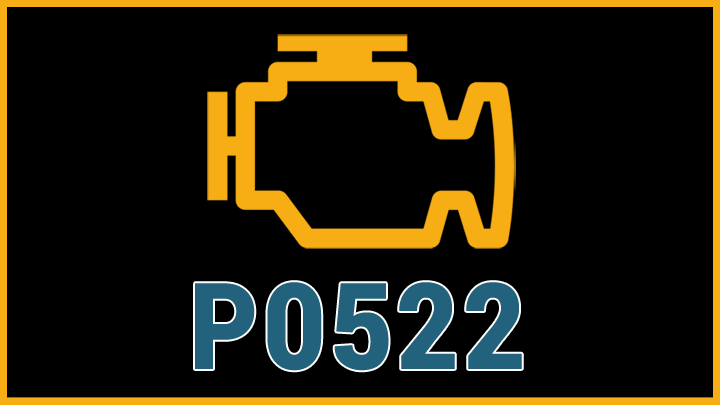P0522 Code (Symptoms, Causes, and How to Fix)
Engine oil pressure warnings prevent catastrophic damage, but when the light comes on, action is required. Diagnostic code P0522 indicates dangerously low pressure.
This guide will cover causes of low oil pressure, steps to diagnose code P0522, and how to address the issue before irreparable damage occurs.

What Does Code P0522 Mean?
Diagnostic trouble code P0522 is indicative of low lubricating engine oil pressure, as presented to the affected vehicle’s PCM/ECM by the engine’s oil pressure sensor/switch. Conversely, related code P0523 would indicate high oil pressure.
Simply put, a vehicle’s operating software has established that feedback presented by the engine’s oil pressure monitoring circuit has fallen outside of its normal operating range, and is trending toward the lower end of its monitoring threshold.
This is of high significance due to the fact that an engine’s moving components require constant lubrication to prevent accelerated wear. In fact, an oil-starved engine can be damaged in mere seconds, and will often fail unconditionally in a minute or less, especially when under a load. Therefore, the presence of this code should be cause for immediate concern.
In the event of an active P0522 fault code, you must quickly determine whether the affected engine is truly suffering from oil pressure loss, or if the vehicle’s PCM has merely been tricked into thinking such, due to a failure in the monitoring circuit.
Knowing this, you will be required to isolate the issue at hand, making a determination regarding whether it is mechanical or electrical in nature.
Related: P0520 Code, P0521 Code
Symptoms of Code P0522

Diagnostic fault code P0522 can be accompanied by a host of secondary symptoms, some of which can be notably severe in nature. Learning to recognize these symptoms as they arise can pay dividends when attempting to resolve the issue at hand.
The following are several of the most common symptoms associated with DTC P0522.
- Illuminated check engine light
- Illuminated oil pressure warning light
- Lack of oil pressure gauge movement
- Intermittent stalling
- Starting-related issues
- Abnormal engine noise
Causes of Code P0522
Code P0522 can be caused by one of several underlying issues, some of which tend to be rather concerning. Understanding the potential causes of this code can prove invaluable when attempting to correct a low lube oil pressure condition.
The following are several of the most common causes of diagnostic trouble code P0522.
- Faulty oil pressure sender
- Damage oil pressure sender wiring
- Lack of lubricating oil pressure
- Compromised PCM
Is Code P0522 Serious?

Diagnostic fault code P0522 is generally considered to be quite severe in nature, due to the potential issues that it often alludes to. In the event that a vehicle’s engine has truly suffered a loss in lubricating oil pressure, the operation should cease immediately, as catastrophic internal engine damage can result from continued driving.
Knowing this, you should never assume that their engine’s oil pressure sender has simply failed. An assumption of this type, without probable cause, can quickly destroy an engine if this assumption proves to be off point.
Therefore, the safest course of action in the event of perceived oil pressure loss is to immediately shut off a vehicle’s engine, before having it towed to its ultimate point of repair.
In any event, the root cause of a vehicle’s P0522 diagnostic trouble code should be diagnosed and repaired as soon as possible. Doing so can greatly reduce the chance of incurring additional damage to a vehicle’s engine that must be repaired before continuing operation.
If you do not feel comfortable tackling such repairs yourself, an appointment should be made with a trusted service center as soon as possible.
How to Fix Code P0522

The following steps can be followed to assist in diagnosing and repairing the root cause of your vehicle’s P0522 diagnostic trouble code. As always, factory-specific service literature for your particular model of the vehicle should be consulted before attempting any such repairs.
#1 – Check For Additional DTCs
Before beginning the diagnostic process, you should check for the presence of additional diagnostic fault codes with the use of a quality scan tool. Any codes uncovered should be thoroughly diagnosed before proceeding.
#2 – Check Oil Level
Begin by simply checking your vehicle’s engine oil level to ensure that it is filled to within its operating capacity. If this is not the case, the affected engine’s oil level should be topped off with oil of the correct viscosity.
#3 – Inspect Oil Pressure Sensor
Next, perform a careful visual inspection of your engine’s oil pressure sender. Ensure that this specific sensor is free of obvious damage and that its connector latches firmly.
It is also important to check for signs of damage to this sensor’s wiring pigtail. Any damage discovered should be repaired immediately.
#4 – Check Sensor Resistance
You can also test the oil sender itself by testing its internal resistance across its terminals, as specified by your vehicle’s manufacturer. These readings should be compared to those specified by applicable service literature.
#5 – Perform Mechanical Tests
Finally, your vehicle’s actual oil pressure can be verified with the use of a mechanical oil pressure gauge.
In-spec readings, in light of passing sensor resistance tests, would indicate a wiring/PCM issue, while lower than specified pressure readings would indicate a mechanical issue within the affected vehicle’s engine.
- P0480 Code (Symptoms, Causes, and How to Fix) - Apr 19, 2024
- Car Temperature Gauge Stopped Working? (Here’s Why) - Apr 15, 2024
- Ignition Coil vs Coil Pack (What’s the Difference?) - Apr 8, 2024
